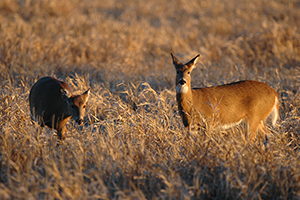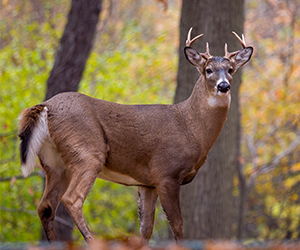White-tailed Deer
Important information on Deer in New Hampshire
Description
 White-tailed deer are tan to reddish-brown during the summer and a grayish-brown in winter months. The tail is brown with a dark center stripe above and white below. This species got its common name from showing the white underside of its tail as a warning of danger to other individuals. The belly, throat, noseband, eye ring, and inside of ears are also white. Bucks (males) have antlers while does (females) do not (with rare exceptions). Antlers have a main beam forward with several smaller tines behind. White-tailed deer vary in size considerably, with mature bucks weighing 150-310 pounds and does between 90-210 pounds.
White-tailed deer are tan to reddish-brown during the summer and a grayish-brown in winter months. The tail is brown with a dark center stripe above and white below. This species got its common name from showing the white underside of its tail as a warning of danger to other individuals. The belly, throat, noseband, eye ring, and inside of ears are also white. Bucks (males) have antlers while does (females) do not (with rare exceptions). Antlers have a main beam forward with several smaller tines behind. White-tailed deer vary in size considerably, with mature bucks weighing 150-310 pounds and does between 90-210 pounds.
Range and Distribution
There are an estimated 30 million white-tailed deer, including subspecies, currently distributed throughout the continental US. The only location they are not commonly found in the US is in Utah, Nevada, and California. They can also be found as far north as southern Canada and as far south as northern portions of South America. They are extremely adaptable to a variety of habitats and have been introduced to a few northern European countries, including Finland.
In New Hampshire, the white-tailed deer population is approximately 100,000 individuals. The areas of greatest densities are in the southern counties (Rockingham, Hillsborough, and Cheshire) and along the Connecticut River Valley (Grafton County). In 2014, the NH Fish and Game Department began the process of revising its 10-year management plan for white-tailed deer, moose, turkey, black bear, snowshoe hare, and ruffed grouse. This document, called the NH Game Management Plan, spans the period of 2016 to 2025. Population level goals for deer were adjusted to more closely reflect current biological conditions and limitation, as well as public interests and concerns. These goals aim to stabilize the deer population in many areas of the state while increasing or reducing it in others.
Habits and Habitats
 White-tailed deer can live in a variety of habitats, including farmlands, brushy areas, woods, mountains, and suburbs and gardens. They feed on green plants, in the summer; acorns, beechnuts, and corn in the fall; and woody vegetation, including buds and twigs of birch, maple and conifers in the winter. White-tailed deer will typically consume 5 to 9 pounds of food each day and find water from snow, dew, and waterbodies.
White-tailed deer can live in a variety of habitats, including farmlands, brushy areas, woods, mountains, and suburbs and gardens. They feed on green plants, in the summer; acorns, beechnuts, and corn in the fall; and woody vegetation, including buds and twigs of birch, maple and conifers in the winter. White-tailed deer will typically consume 5 to 9 pounds of food each day and find water from snow, dew, and waterbodies.
Individual deer group into two types of social combinations. These include the family group, with a doe and her young, and the buck group. The family group will stay together for approximately a year. Buck groups are structured with a dominance hierarchy of 3 to 5 individuals. Bucks will challenge each other with stares, lowered ears, kicking, sparring (physically pushing each other back), and less commonly, thrashing of forefeet.
During the winter, these two deer groups may come together, forming communities of up to 150 individuals in locations called “yards.” This unification keeps trails open and accessible for feeding and also provides protection from predators. However, there have been problems with humans providing supplementary feed sites for deer in the winter. These sites can cause unnaturally high densities of congregated deer that attract predators, increase the risk of disease transmission, increase aggression within the community, and lead to over-browsing of local vegetation and more deer-vehicle collisions. They cause deer to be more dependent on humans and artificial food sources that provide few benefits.
Fish and Game does not advocate the supplemental feeding of deer, will not participate in winter feeding efforts, and urges landowners not to feed deer. To learn more, read More Harm than Good
Mating season varies within the species range.. In the Northeast, the white-tail rut consistently peaks in November. Rut timing is much more variable across southern states, with the peak occurring anywhere from August through February, depending on location. In NH, breeding dates are fairly consistent throughout the state and roughly 80% of breeding takes place over a 3-week period starting around mid-November. Buck groups split up and several bucks follow a doe’s scent from a distance of 150 feet. The dominant buck may compete with others and mate with several does. After mating season, does return to subgroups until early spring. Females have a gestation time of 6.5 months. In their first year of mating, does produce one fawn. After this initial year, they commonly produce twins or triplets annually. The majority of fawns are born in June and stay with their mother until right before the next year’s birth.
White-tailed deer are able to swim, run and jump extremely well. Winter coats of northern deer have hollow hair shafts that fill with air. This makes the coat so buoyant that it is hard for an animal to sink if exhausted. White-tailed deer can run at speeds up to 36 mph, although they typically run to the nearest cover and never for long distances. A deer can also leap 8.5 feet vertically and 30 feet horizontally.
White-tailed deer shed their antlers annually, usually around February. A buck’s first antlers may be solitary spikes, but in their third year, it is expected for them to have about 8 points. The size and structure of antlers differ greatly because of nutritional factors. Despite common belief, you cannot tell a deer's age by its antlers; the age of a deer is most commonly determined by observing the wear on its teeth.
Management
Despite the species being greatly reduced in the US by the early 20th century because of unregulated hunting and habitat loss, white-tailed deer numbers have increased significantly and populations are thriving. This rebound has also been seen in many areas of NH. Due to these rebounds, the Game Management Plan outlines goals and objectives for stabilizing the white-tailed deer population in many parts of New Hampshire based on both ecological and cultural carrying capacities. Biologists and managers look at the availability of suitable habitat for populations and how many individuals it can sustain. They also consider the tolerance level of white-tailed deer abundance for humans in an area. In New Hampshire, as well as many other states, hunting is used as a tool for management and provides recreation and lean meat to residents and visitors during the fall months.
Lyme disease is a concern in New Hampshire, as it is in much of New England. NH Fish and Game asks residents and visitors to take care to avoid ticks when out hiking in typical deer habitats, especially during spring and summer. Wearing long pants, a long-sleeved shirt and using insect repellent may help protect against both tick and mosquito bites. One of the most important things you can do to prevent tick bites is performing a tick check anytime you have visited an area where you may have been exposed to ticks. Tick bites can go unnoticed so, also watch for symptoms of Lyme disease, which can include headache, dizziness, fever, sore throat, muscle aches, joint pain, general weakness, and a bull's-eye red rash around the bite area. Get more information about avoiding tick-borne diseases.
Deer-vehicle collisions are also of concern. NH Fish and Game urges drivers to be alert for the presence of deer when driving, especially around dusk or dawn and particularly during the fall breeding season when deer activity and movement increases. Drive at low speeds with high beams on (whenever possible) while scanning the roadsides.
Chronic wasting disease (CWD), a brain disease that is AWAYS FATAL to deer, moose and elk. It is one of the greatest concerns for deer hunters and managers due to its potential to have devastating long term impacts to deer populations and our hunting heritage. Annual monitoring efforts since 2002 have not detected CWD in any New England state; however it has been detected as close as New York, Pennsylvania, and Maryland. Prevention of CWD in New Hampshire remains a top priority and hunters should take every effort to learn more about the impacts this disease can have on deer populations and what they can do to help stop its spread.



